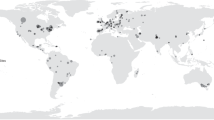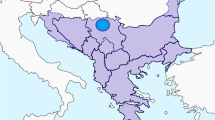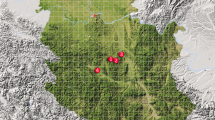Abstract
Earthworms are important soil organisms yet we have limited knowledge on the geographical distribution of species. Using data from a variety of sources representing a total of 3,941 locality records we have produced the first distribution maps of earthworm species in the British Isles The maps highlight the paucity of knowledge on this ecologically important group. A systematic approach needs to be taken to bring earthworm species data to a level comparable with other important invertebrate groups such as nematodes and isopods. Through the recent establishment of an earthworm recording scheme, the Earthworm Society of Britain, working with the Biological Records Centre and earthworm researchers across the British Isles, aim to build comprehensive distribution information for future monitoring and research purposes.






Similar content being viewed by others
References
Amador JA, Gorres JH (2007) Microbiological characterisation of the structures built by earthworms and ants in an agricultural field. Soil Biol Biochem 39:2070–2077
Boag B, Palmer LF, Neilson R, Legg R, Chambers SJ (1997) Distribution, prevalence and intensity of earthworm populations in arable land and grassland in Scotland. Ann Appl Biol 130:153–165
Brinkhurst RO (1971) A guide to the identification of British aquatic Oligochaeta. Freshwater Biological Association, Ambleside
Cernosvitov L, Evans AC (1947) Lumbricidae (Annelida), with a key to the common species. Synopsis of the British Fauna No. 6. The Linnean Society, London
Darwin C (1881) The formation of vegetable mould through the action of worms, with observations on their habits. John Murray, London
Decaëns T, Jiménez JJ (2002) Earthworm communities under an agricultural intensification gradient in Colombia. Plant Soil 240:133–143
Decaëns T, Margerie P, Aubert M, Hedde M, Bureau F (2008) Assembly rules within earthworm communities in North-Western France—a regional analysis. Appl Soil Ecol 39:321–335
Edwards CA, Bohlen PJ (1996) Biology and ecology of earthworms, 3rd edn. Chapman and Hall, London
Eggleton P, Inward K, Smith J, Jones DT, Sherlock E (2009) A six year study of earthworm (Lumbricidae) populations in pasture woodland in southern England shows their responses to soil temperature and soil moisture. Soil Biol Biochem 41:1857–1865
Friend H (1923) British earthworms and how to identify them. Epworth Press, London
Gerard BM (1964) British Lumbricidae. Synopses of the British Fauna No. 6. The Linnean Society, London
Gregory S (2009) Woodlice and Waterlice (Isopoda: Oniscidea & Asellota) in Britain and Ireland. Published for Biological Records Centre by FSC Publications, Shrewsbury
Haynes RJ, Fraser PM (1998) A comparison of aggregate stability and biological activity in earthworm casts and undigested soil as affected by amendment with wheat or lucerne straw. Eur J Soil Sci 49:629–636
Heath J, Brown DJF, Boag B (1977) Provisional Atlas of Nematodes of the British Isles. Biological Records Centre, Abbots Ripton
Hickling R, Roy DB, Hill JK, Fox R, Thomas CD (2006) The distributions of a wide range of taxonomic groups are expanding polewards. Global Change Biol 12:450–455
Jegou D, Schrader S, Diestel H, Cluzeau D (2001) Morphological, physical and biochemical characteristics of burrow walls formed by earthworms. Appl Soil Ecol 17:165–174
Jones HD, Santoro G, Boag B, Neilson R (2001) The diversity of earthworms in 200 Scottish fields and the possible effect of New Zealand land flatworms (Arthurdendyus triangulatus) on earthworm populations. Ann Appl Biol 139:75–92
Lavelle P, Bignell D, Lepage M, Wolters V, Roger P, Ineson P, Heal OW, Dhillon S (1997) Soil function in a changing world: the role of invertebrate ecosystem engineers. Eur J Soil Biol 33:159–193
Luff ML (1998) Provisional atlas of the ground beetles (Coleoptera, Carabidae) of Britain. Biological Records Centre, Huntingdon
Nunes DH, Pasini A, Benito NP, Brown GG (2006) Earthworm diversity in four land use systems in the region of Jaguapitã, Paraná State, Brazil. Caribb J Sci 42:331–338
Pereira HM, Cooper HD (2006) Towards the global monitoring of biodiversity change. Trends Ecol Evol 21:123–129
Schmidt O, Keith AM, Arroyo J, Bolger T, Boots B, Breen J, Clipson N, Doohan FM, Griffin CT, Hazard CH, Niechoj R (2011) CréBeo—Baseline data, response to pressures, functions and conservation of keystone micro- and macro-organisms in Irish soils. STRIVE Report Series No. 67. Environmental Protection Agency, Co., Wexford, Ireland
Scullion J, Neale S, Phillips L (2002) Comparisons of earthworm populations and cast properties in conventional and organic arable rotations. Soil Use Manage 18:293–300
Sherlock E, Carpenter D (2009) An updated earthworm list for the British Isles and two new ‘exotic’ species to Britain from Kew Gardens. Eur J Soil Biol 45:431–435
Shipitalo M, Nuutinen V, Butt KR (2004) Interaction of earthworm burrows and cracks in a clayey, subsurface-drained soil. Appl Soil Ecol 26:209–217
Sims RW, Gerard BM (1985) Earthworms. Synopses of the British Fauna (New Series). Linnean Society of London, The Estuarine and Coastal Sciences Association and Field Studies Council, London
Sims RW, Gerard BM (1999) Earthworms. Synopses of the British Fauna (New Series). Linnean Society of London, The Estuarine and Coastal Sciences Association and Field Studies Council, London
Southern R (1909) Contributions towards a monograph of the British and Irish Oligochaeta. Proc R Irish Acad 27:119–182
Whitehead P, Keates C (1981) The British Museum Natural History. Philip Wilson, London
Wilson RJ, Thomas CD, Fox R, Roy DB, Kunin WE (2004) Spatial patterns in species distributions reveal biodiversity change. Nature 432:393–396
Zimmer M, Kautz G, Topp W (2005) Do woodlice and earthworms interact synergistically in leaf litter decomposition? Funct Ecol 19:7–16
Acknowledgments
We thank Madeleine Malgram, Edison Hynch, and Louise Berridge for help with collections data compilation. Thanks also to Edward Mills for his help with GIS mapping.
Author information
Authors and Affiliations
Corresponding author
Electronic supplementary material
Below is the link to the electronic supplementary material.
Rights and permissions
About this article
Cite this article
Carpenter, D., Sherlock, E., Jones, D.T. et al. Mapping of earthworm distribution for the British Isles and Eire highlights the under-recording of an ecologically important group. Biodivers Conserv 21, 475–485 (2012). https://doi.org/10.1007/s10531-011-0194-x
Received:
Accepted:
Published:
Issue Date:
DOI: https://doi.org/10.1007/s10531-011-0194-x




